Abstract
Purpose
Obstructive sleep apnea (OSA) is a common chronic condition, associated with several conditions that account for leading causes of mortality. Adherence to treatment of a chronic condition is, along with treatment efficacy, a major determinant of treatment outcome. The aim of this study was to test whether or not a multifactorial intervention in addition to standard care increases adherence rates in patients using a titratable oral appliance for OSA.
Methods
All subjects were 18 years old or older, had a diagnosis of OSA, and were treated with an oral appliance with an embedded sensor to measure appliance wear time objectively. The control group received routine care, while the experimental subjects received an additional multifactorial intervention. Comparison of adherence was at 30 days (Phase I) and 90 days (Phase II) after appliance delivery.
Results
Data are reported for 82 subjects in Phase I (control 43; experimental 39) and 66 subjects in Phase II (control 36; experimental 30). There were no significant differences for age, sex, body mass index, and apnea-hypopnea index (p > 0.05) between groups. In both Phase I and Phase II, the mean number of nights the appliance was worn 4 or more hours and the mean time the appliance was worn nightly were significantly greater in the experimental than in the control group (p < 0.05).
Conclusions
Interventions were well received by subjects and can be carried out by auxiliary personnel. The experimental interventions resulted in clinically important and statistically significant improvements in patient adherence to treatment.

Similar content being viewed by others
References
Peppard PE et al (2013) Increased prevalence of sleep-disordered breathing in adults. Am J Epidemiol 177(9):1006–1014
Young T, Peppard PE, Gottlieb DJ (2002) Epidemiology of obstructive sleep apnea: a population health perspective. Am J Respir Crit Care Med 165(9):1217–1239
Xia F, Sawan M (2021) Clinical and research solutions to manage obstructive sleep apnea: a review. Sensors (Basel) 21(5)
Peppard PE, Hagen EW (2018) The last 25 years of obstructive sleep apnea epidemiology-and the next 25? Am J Respir Crit Care Med 197(3):310–312
Heinzer R et al (2015) Prevalence of sleep-disordered breathing in the general population: the HypnoLaus study. Lancet Respir Med 3(4):310–318
Ferguson KA et al (1997) A short-term controlled trial of an adjustable oral appliance for the treatment of mild to moderate obstructive sleep apnoea. Thorax 52(4):362–368
Barnes M et al (2004) Efficacy of positive airway pressure and oral appliance in mild to moderate obstructive sleep apnea. Am J Respir Crit Care Med 170(6):656–664
Phillips CL et al (2013) Health outcomes of continuous positive airway pressure versus oral appliance treatment for obstructive sleep apnea: a randomized controlled trial. Am J Respir Crit Care Med 187(8):879–887
Ramar K et al (2015) Clinical practice guideline for the treatment of obstructive sleep apnea and snoring with oral appliance therapy: an update for 2015. J Clin Sleep Med 11(7):773–827
Burkhart PV, Sabaté E (2003) Adherence to long-term therapies: evidence for action. J Nurs Scholarsh 35(3):207
De Geest S, Sabaté E (2003) Adherence to long-term therapies: evidence for action. Eur J Cardiovasc Nurs 2(4):323
Osterberg L, Blaschke T (2005) Adherence to medication. N Engl J Med 353(5):487–497
Organization WH (2003) Adherence to long-term therapies:evidence for action
Burudpakdee C et al (2015) Impact of patient programs on adherence and persistence in inflammatory and immunologic diseases: a meta-analysis. Patient Prefer Adherence 9:435–448
Semelka M, Wilson J, Floyd R (2016) Diagnosis and treatment of obstructive sleep apnea in adults. Am Fam Physician 94(5):355–360
Bartlett D et al (2013) Increasing adherence to obstructive sleep apnea treatment with a group social cognitive therapy treatment intervention: a randomized trial. Sleep 36(11):1647–1654
Weaver TE, Sawyer A (2009) Management of obstructive sleep apnea by continuous positive airway pressure. Oral Maxillofac Surg Clin North Am 21(4):403–412
Schmidt-Nowara WW, Meade TE, Hays MB (1991) Treatment of snoring and obstructive sleep apnea with a dental orthosis. Chest 99(6):1378–1385
Ringqvist M et al (2003) Dental and skeletal changes after 4 years of obstructive sleep apnea treatment with a mandibular advancement device: a prospective, randomized study. Am J Orthod Dentofacial Orthop 124(1):53–60
Ferguson KA et al (2006) Oral appliances for snoring and obstructive sleep apnea: a review. Sleep 29(2):244–262
Feldman R et al (1998) Adherence to pharmacologic management of hypertension. Can J Public Health 89(5):I16–I18
Bonato R, Bradley DC (2013) Introducing a novel micro-recorder for the detection of oral appliance compliance: DentiTrac®
Dieltjens M et al (2013) Objectively measured vs self-reported compliance during oral appliance therapy for sleep-disordered breathing. Chest 144(5):1495–1502
Nieuwlaat R et al (2014) (2014) Interventions for enhancing medication adherence. Cochrane Database Syst Rev 11:Cd000011
Jin J et al (2008) Factors affecting therapeutic compliance: a review from the patient’s perspective. Ther Clin Risk Manag 4(1):269–286
Woehrle H, Graml A, Weinreich G (2011) Age- and gender-dependent adherence with continuous positive airway pressure therapy. Sleep Med 12(10):1034–1036
Tallamraju H, et al. (2021) Factors influencing adherence to oral appliance therapy in adults with obstructive sleep apnea: a systematic review and meta-analysis. J Clin Sleep Med
(2007) Enhancing prescription medicine adherence: a national plan. National Council on Patient Information and Education
Murphy S, et al. (2020) Adherence and side effects among patients treated with oral appliance therapy for obstructive sleep apnea. J Dent Sleep Med 7
Acknowledgements
We thank The Ohio State University Division of Orthodontics and The Ohio State College of Dentistry Dental Faculty Practice for their participation and cooperation.
Funding
This study was funded by the American Sleep Medicine Foundation and the American Academy of Dental Sleep Medicine (175-DR-17). Braebon Medical Corporation donated DentiTrac® sensors and baseplate.
Author information
Authors and Affiliations
Contributions
J. L. contributed to study conceptualization, methodology, investigation, validation, data curation, formal analysis, and writing—original draft, review, and editing. V. S. and R. M. contributed to study concept, design, and data collection. A. N. contributed to study design and statistical analysis. U. M. contributed to study concept and design. C. K. contributed to study concept, design, and writing. A. F. contributed to study conceptualization, methodology, investigation, validation, data curation, formal analysis, writing, project administration, and funding acquisition and supervision.
Corresponding author
Ethics declarations
Ethical approval
All procedures performed in studies involving human participants were in accordance with the ethical standards of Ohio State University Institutional Review Board (IRB number: 2020H0406).
Informed consent
Informed consent was obtained from all individual participants included in the study.
Conflict of interest
The authors declare no competing interests.
Additional information
Publisher's note
Springer Nature remains neutral with regard to jurisdictional claims in published maps and institutional affiliations.
This paper was submitted in partial fulfillment of the requirements for the degree of Master of Science in the Graduate School of The Ohio State University.
This article is part of the Topical Collection on Oral Appliance Therapy
Rights and permissions
About this article
Cite this article
Liu, J., Sheets, V., Maerz, R. et al. A multifactorial intervention to increase adherence to oral appliance therapy with a titratable mandibular advancement device for obstructive sleep apnea: a randomized controlled trial. Sleep Breath 26, 1739–1745 (2022). https://doi.org/10.1007/s11325-021-02548-0
Received:
Revised:
Accepted:
Published:
Issue Date:
DOI: https://doi.org/10.1007/s11325-021-02548-0




